#Gustav Schmidt
Text
The castings for Sophie and Ludwig Wilhelm are actually pretty good? They both look like they could pass as Dominique's siblings!


(needless to say they look nothing like their historical counterparts lol)
Not really sure about the Ludwig II guy, he isn't giving me Ludwig vibes yet yknow? I'm gonna wait to see him in costume to give my veredict looks-wise


#philine schmölzer#rick okon#gustav schmidt#I don't really have anything to say about antonia moretti (henriette mendel) and the guy i guess is the bay middleton stand-in#sisi (2021)
2 notes
·
View notes
Text
Hey everyone- idk who’s actually gonna read this but I’ve been wanting to start writing on here for awhile now and I’m probably gonna start doing it, here’s something’s about me ig
~About Me~
My name is Vinny!
⋆
I’m Transgender FTM! (He/him please babes!)
⋆
I’m not comfortable sharing my age just yet:)
⋆
My username is something old but never intended for something romantic- if anyone knows how to change usernames please let me know😭
If I do ever change my username it will be “V1nnyDinny” (let’s hope I can put it as that-)
⋆
I plan on being an Actor and I’m waiting to get put in acting classes :) (I have to learn to stop cussing all the time before my mom puts me in tho-😭🤚🏻)
ANYWAYS-
I don’t really know much about myself tbh but I’ll try to give you at least a note yeah?
⋆things I like⋆
-Stranger things
-Tokio Hotel (all of them duhh)
-the black phone
-Rodrick🙈
-fnaf (as well as the movie, like omg? The movie was great!!)
-my cats ofc?!
-SLEEP. Gn😊
~Things I’ll Write~
-Tokio Hotel (OFCCC)
-Stranger Things
-Rodrick from diary of a wimpy kid
-probably the fnaf movie too-
-my hero academia (?!)
-I might do some welcome home maybe? I’ll have to get to know a bit more about the site first!
-definitely creepypasta!
-maybe stuff with Mason Thames, Miguel Mora- yk all the black phone cast members??
That’s kinda all I like rn but I’ll always update!
⋆Stuff I Will And Won’t Write!⋆
-definitely NOT gonna write about reader getting r@ped. However I will write things like comfort from flashbacks, stuff like that
-Smut (all smut will be aged up!)
-Any type of hcs!
-OneShots
-fluff
-angst? Idk if I spelt that right💀
-comfort
-ig pretty much anything- if I’m not comfortable with it I’ll lyk ☻
I’ll do any genders and pronouns!
Male/Female/
He/him she/her they/them she/they he/they! You name it! I’ll make it happen ☻
PLEASE SEND ME REQUEST LOVES!!🙏🏻🙏🏻
(GIF from Pinterest)

#mha#the black phone#tokio hotel#tom kaulitz#bill kaulitz#georg listing#gustav schäfer#the grabber#finney blake#robin arellano#vance hopper#billy showalter#stranger things#billy hargrove#steve harrington#eddie munson#rodrick heffley#fnaf movie#mike schmidt
18 notes
·
View notes
Text
Passus duriusculus
Johann Sebastian Bach (1685 - 1750): Weinen, Klagen, Sorgen, Zagen, cantata BWV 12 su testo di Salomo Franck (forse) e Samuel Rodigast (n. 7); eseguita per la prima volta a Weimar il 22 aprile 1714. Paul Esswood, contraltista; Kurt Equiluz, tenore; Max van Egmond, basso; Tölzer Knabenchor, dir. Gerhard Schmidt-Gaden; King’s College Choir Cambridge, dir. David Willcocks; Leonhardt-Consort, dir.…
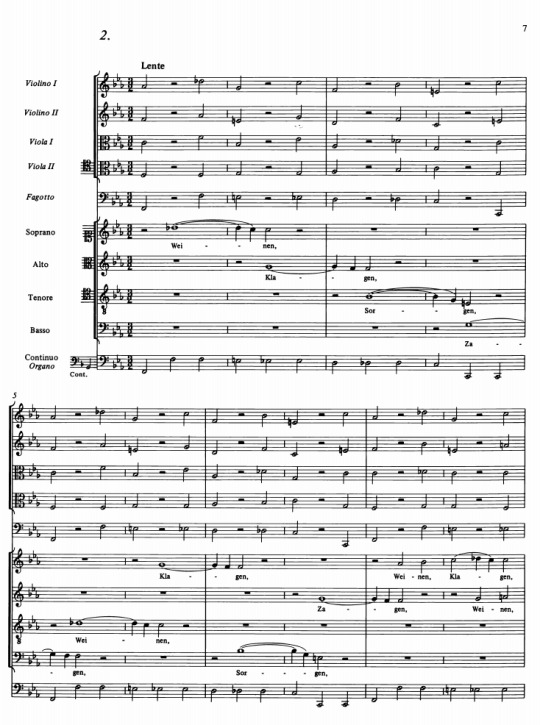
View On WordPress
#Alexander Wilhelm Gottschalg#Anton Grigor&039;evič Rubinštejn#Artur Aksenov#Blandine Ollivier#Catherine-Adelaide Méran#David Willcocks#Gerhard Schmidt-Gaden#Gustav Leonhardt#Johann Sebastian Bach#King&039;s College Choir Cambridge#Kurt Equiluz#Leonhardt-Consort#Max van Egmond#passus duriusculus#Paul Esswood#Salomo Franck#Samuel Rodigast#Tölzer Knabenchor#Thibaut Duret#Vladimir Horowitz
0 notes
Text
Planet Childs
Jean-Baptiste Cariven 1843/1904, French, seated child
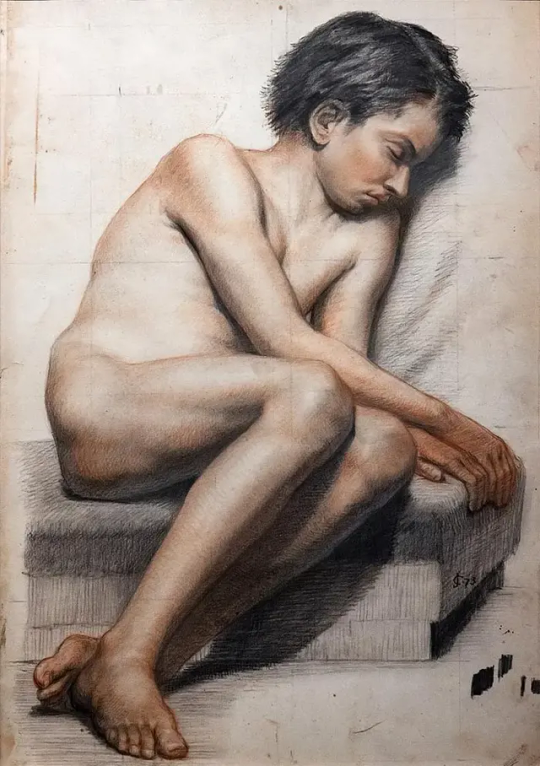
Cauer Stanislaus, 1867/1943, boy tying his headband
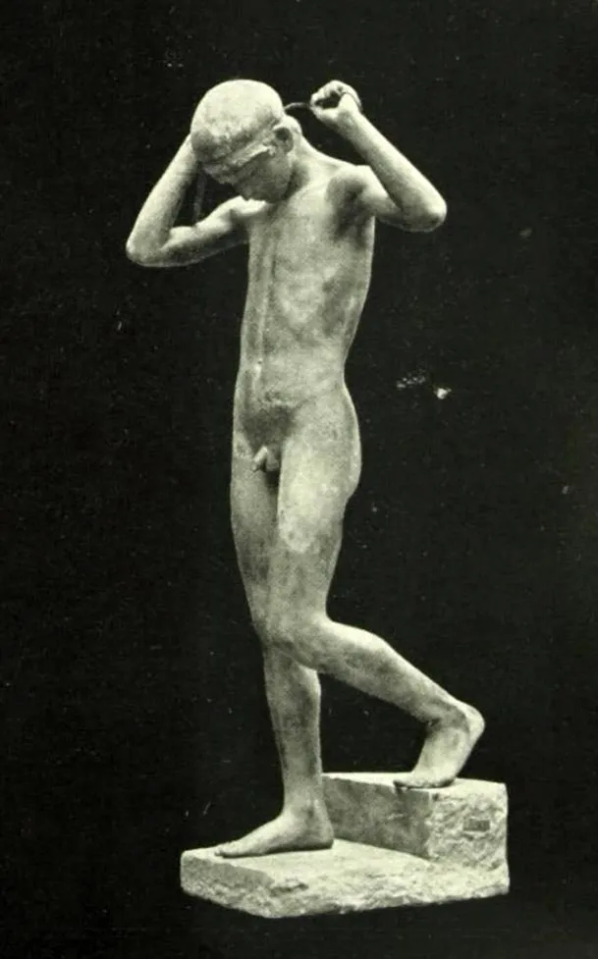
Richard P. Eichman, 1941/2001, American, Young Discobol.
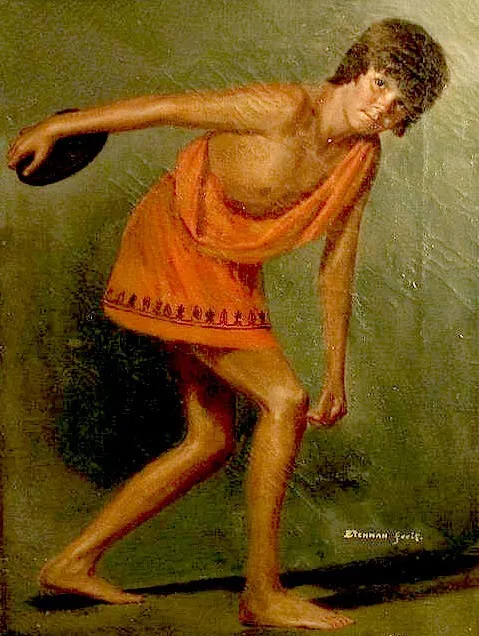
Wim Van der Kant, b.1949, Holland, Crepis

Richard P. Eichman, Aulos player

Wim Van der Kant, b.1949, Holland, Aestus
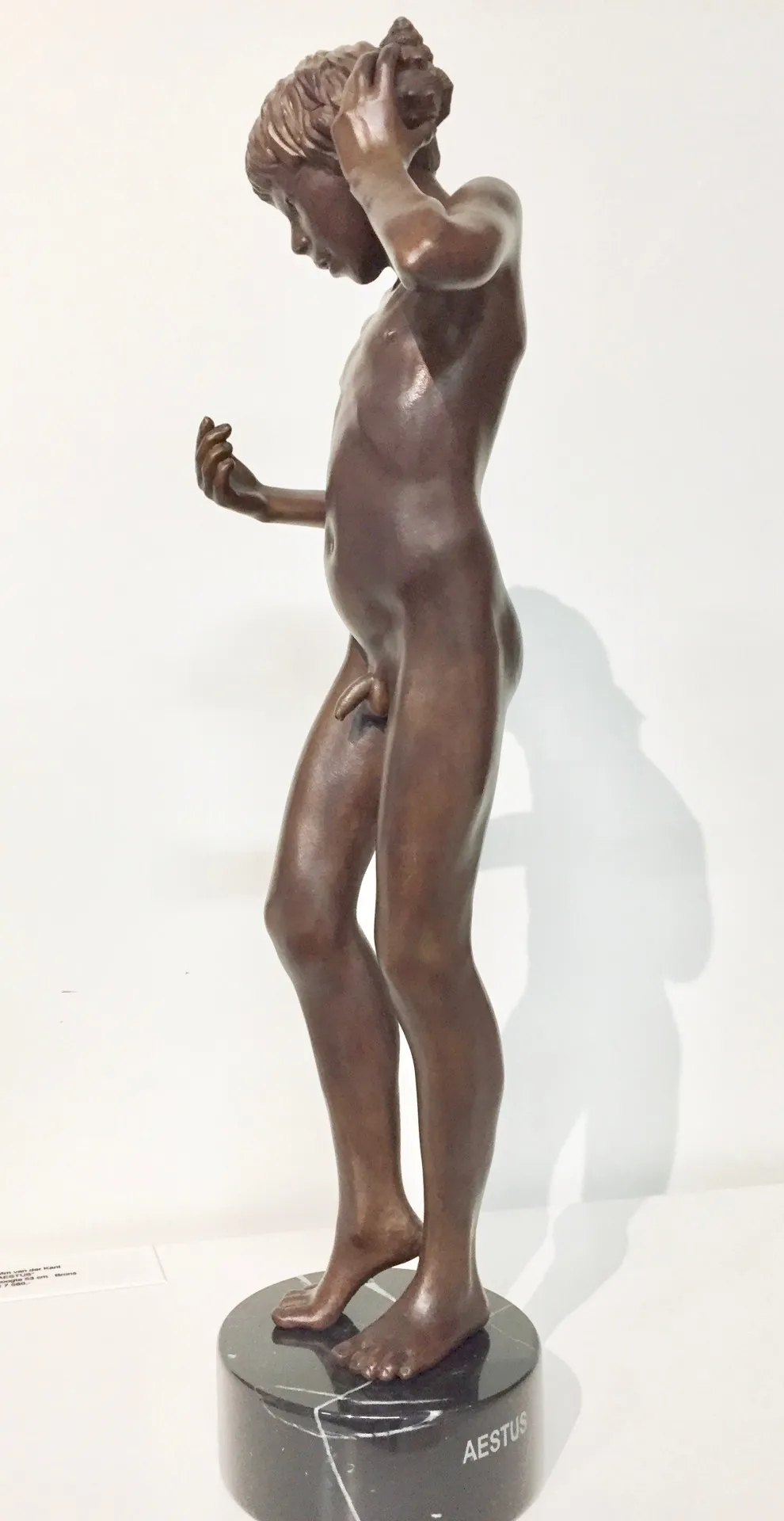
Richard P. Eichman, Ganiméde

Bertel Hansen-Svaneke, 1883/1937, Danish, Boys bathing from cliffs at Bornholm

Messina Francesco, Italian, 1900/1995, young fisherman

Gustav Klimt, 1862/1918, Austrian, Savoyarden-Knabe
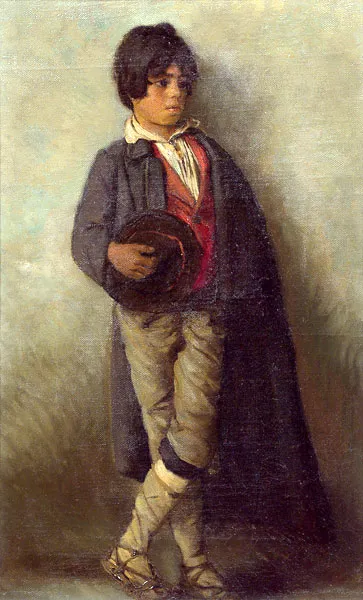
Ruolf Schmidt, b.1959, two boys playing ball.
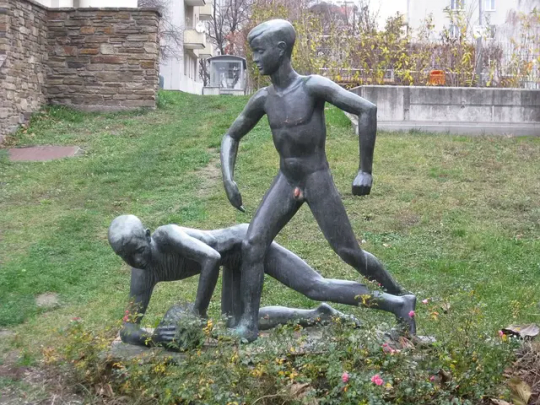
Located Kopenhagen-Hof, Schegargasse, 13-15, Vienna, Austria, it seems that one "enjoys" more attention than the other…
19 notes
·
View notes
Photo

Apartment Building (1957-58) at Interbau 1957 in Berlin, Germany, by Gustav Hassenpflug. Photo by Franziska Schmidt.
#1950s#apartment building#architecture#germany#nachkriegsmoderne#nachkriegsarchitektur#architektur#berlin#interbau 1957#gustav hassenpflug
171 notes
·
View notes
Text
RTL has shared the new casting announcement and a first premise of the fourth season of Sisi (2021). Spoilers below the cut.

After the death of her father, Sisi challenges Bavaria's best jockey to a big horse race to save the family estate Possenhofen Castle. Back at home, The Empress discovers dark family secrets and must ask herself where she truly feels at home.

The cast this season is mostly expanded around Sisi's birth family. Philine Schmölzer will play her youngest sister Sophie, Rick Okon her oldest brother Ludwig "Louis" in Bavaria and Gustav Schmidt her maternal cousin King Ludwig II of Bavaria. Furthermore the fourth season introduces Antonia Moretti as Henriette Mendel, actress and morganatic wife of Louis. The jockey Sisi challenges is called George Basselet von La Rossé and played by Klaus Steinbacher.
#Sisi#Sisi (2021)#costume drama#historical drama#period drama#german tv#german series#behind the scenes#sisi.rtl
16 notes
·
View notes
Text
WIP Questionnaire
Thank you kindly for the Tag, @theprissythumbelina !
1. What is the first part of your WIP that you created?
Well, the Setting, probably, which as an answer works for just about any of the WIPs I could name. In theory you could argue Gustav and the Magician, individually and as a 'set' of sorts, technically predate my coming up with the 12 Worlds, but the form they took then has only passing resemblance to their current incarnation.
2. If your story was a TV show, what would the theme song/intro be?
Ooo, well, I've been thinking I'd probably see about getting something original made, or making something myself as a side thing. I mean, I kinda envision a lot of my WIPs as serial animations in my head anyhow, so I've put more thought into this question than reality is ever likely to require.
3. What are your favorite characters that you made? Why?
Well... You know how big this list could be. I love all of them, and at any moment which forces / allows me to dig deeper into any single one of them makes me love them even more. Still, my final choice is an obvious one: Gustav Johann Schmidt, who's been in it since the very start, and who's voice has by now almost become my own whenever he comments on some facet of his world in the same way I would.
4. What other pieces of media do you think your fan base would share?
Hmm, well, I've always thought this would go down two tracks. First of all being the classic 'Techno Thriller' crowd, the sorts who like tanks going boom and spies under deep cover: I'd go with things like The Hunt For Red October and Red Storm Rising, both being stalwarts of the genre which have absolutely been personally inspiring. The second track goes down the wider book / writing community, or at least those looking for 'genre fiction' and all that, who might discover the 12 Worlds more on its fantastical or worldbuilding grounds than for its techno thriller nature: I don't really 'understand' what I'd mean by this cohort myself as much, but I guess it could include series like ASOIAF, possibly.
5. What has been your biggest struggle with your WIP?
Well... If we're speaking in the past tense, as far as things that have already happened go I'd put forwards "making sure the worldbuilding exists and isn't utterly contradictory", since there's too little writing down so far to count for a big struggle. Dates are hard, and measuring things on the order of decades to a century leaves me with a lot of uncomfortable dead space on one hand, and a bunch of events clustered together on the other. Untangling this has to happen before the writing does, to me, and it's gonna be hellish.
6. Are there any animals in your story? Talk about them!
Uhh... Technically, Snake In The Sandbox (Gustav's third and least brought up WIP) features two animals! One's a snake which literally scares G's shirt off when he finds it in his tent, and the other's some sort of desert lizard the 18th Corps adopts as its mascot.
7. How do your characters get around? (Ex. Trains, horses, cars, dragons, etc.)
Oh, probably their respective combat vehicles more than anything, though long distance stuff gets done by plane / aeroship, and getting between Worlds means ships for everyone. Non military types might get their own car, or plane.
8. What part of your WIP are you working on right now?
Technically brought this up already, but the answer's worldbuilding. It's always worldbuilding. Though within that category, I'm technically supposed to be writing up a piece on the UC' policy towards Goilac / Nouvoulouis pre SSAW, but... I have been having a lazy weekend.
9. What aspects (tropes, maybe) of your WIP do you think will draw people in?
Big flashy boom booms and cunning military tactics, strategy, and leadership on the one hand for sure, but I'd like to think the depth, history, and life that exists within the 12 Worlds might have some appeal to readers.
10. What are your hopes for your WIP?
Published novel, or really a few considering how many there are already for the 12 Worlds. Then... Well, I think I've got a few ideas in me for the Setting yet.
Anyone fancy a boardgame?
And that's that! Tagging @athenswrites @hessdalen-globe @caxycreations @sanguine-arena @vyuntspakhkite-l-darling @thatndginger and anyone who'd like to take part!
12 notes
·
View notes
Text
Nicholas II’s little known third brother: Alexander (1869-1870)

Up until the early 20th century infant mortality in Imperial Russia was among the highest in the world. Many a family lost at least one child either during childbirth or disease. Infant mortality was something that did not discriminate, regardless of one’s position in life, including members of the Russian Imperial Family.
Grand Duke Alexander Alexandrovich was born on 7th June (O.S. 26th May) 1869. He was the second child, of the then Tsesarevich Alexander Alexandrovich (future Emperor Alexander III) and Tsesarevna Maria Feodorovna (future Empress Maria Feodorovna, née Princess Dagmar of Denmark).
Alexander was the younger brother of the future Emperor Nicholas II, and third in line to the Russian throne at the time of his birth.
Sadly, the “Angel Alexander” did not live a full year, he died of bacterial meningitis, one month before his first birthday, on 2nd May (O.S. 20th April) 1870, age 10 months and 26 days.
The doctors who observed the infant – obstetrician Jacob Schmidt, pediatrician Karl Rauchfus and surgeon Gustav Hirsch recorded the course of the disease in detail. They noted that on the night of 15/16 April, after the secondary flu which infected the child’s right lung, signs of acute damage to the meninges appeared. On 17th April, there was a “slight improvement in the patient’s condition”, on 18th April – “a feverish state of moderation”, on 19th April – “for the most part he was conscious”, but the next day there was a deterioration and sudden death. Tsesarevich Alexander wrote in his diary: “God, what a day You sent us and what is this test that we shall never forget to the end of our lives? Be it Your Will Lord and we shall conciliate before You and Your Will.”
“The doctors maintain he did not suffer, but we suffered terribly to see and hear him,” Maria Feodorovna wrote to her mother, Queen Louise of Denmark.
Grand Duke Alexander was sketched on his deathbed by the famous Russian portrait artist Ivan Nikolaevich Kramskoi (1837-1887). The only photograph of the “Angel Alexander”, was taken by his parents posthumously.
Sergei D. Sheremetev, the adjutant to Tsesarevich Alexander, accompanied the infant’s body on horseback to the Peter and Paul Fortress in St. Petersburg, where he was buried in the SS Peter and Paul Cathedral. The infant Grand Duke Alexander Alexandrovich was laid to rest in the northern nave of the Peter and Paul Cathedral in a tiny white marble sarcophagus. On the upper edge of the sarcophagus there is a gilded cross made of bronze, on the side there is a bronze plaque with an epitaph inscribed on it
Alexander’s death was the first of many personal losses which the Empress Maria Feodorovna would endure before her own death in 1928. She outlived her beloved husband “Sasha”, her parents, her sister Alexandra, all four of her sons, and five grandchildren.
#maria nikolaevna#grand duchess xenia#zar nicolás ii#nicholas ii#tatiana nikolaevna#the romanovs#xenia alexandrovna#romanov#tsarina alexandra#grand duchess olga#farah diba pahlavi#grandduchessoganikolaevnaromanova#grandduchessolganikolaevna#olganikolaevnaromanova#olganikolaevna#grandduchessanastasianikolaevna#anastasianikolaevna#grandduchessmarianikolaevna#marianikolaevnaromanova#marianikolaevna#tatiananikolaevnaromanova#tatiananikolaevna#grandduchesstatiananikolaevna#tsarevichalexeinikolaevich#alexeinikolaevichromanov#alexeinikolaevich#dagmarofdenmark#mariafeodorovna
31 notes
·
View notes
Text
tumblr nezná 100 filmů! aneb 18. statistika

Nenasytná Tiffany (2015) : nezná 91,5 %, vidělo 4,2 %
Konec srpna v hotelu Ozon (1966) : nezná 88,3 %, vidělo 5 %
Záhrada (1995) : nezná 86,1 %, vidělo 1,4 %
O slavnosti a hostech (1966) : nezná 84,6 %, vidělo 6,2 %
V žáru královské lásky (1990) : nezná 84,4 %, vidělo 6,3 %
Hezké chvilky bez záruky (2006) : nezná 84,1 %, vidělo 1,4 %
Pirko (2016) : nezná 83,6 %, vidělo 1,5 %
Anděl Exit (2000) : nezná 83 %, vidělo 1,9 %
Dívka s mušlí (1980) : nezná 82,5 %, vidělo 4,8 %
Eva Nová (2015) : nezná 81,4 %, vidělo 1,7 % N
nenáhodné poznatky: speciální faktoidní edice
zastoupení filmů podle dekády vypadá takto:
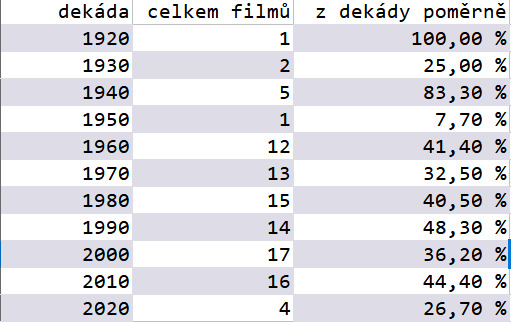
Tedy nejvíce filmů ze stovky neznámých pochází z počátku tisíciletí, následují roky 2010–19 a na třetím místě máme osmdesátky. Ale pokud se podíváme na všechny filmy z daného desetiletí, zjistíme, že nejméně známe filmy z čtyřicátých let (v absolutních číslech je to pět filmů neznámých a jeden známý, ale neviděný), dvacátá léta nepočítaje. Naopak nejvíce známe filmy z padesátek, což není překvapivé, protože většina filmů z tohoto období, o kterých se hlasovalo, byly pohádky nebo klasiky typu Švejk.
nejvíce neznámých filmů je z roku 1966, je jich... 6 (*devil eyes*)
o těchto filmech v průměru hlasuje 65,93 člověka (dovolím si říct... 66), u všech filmů je to 71,18 osoby a u viděných filmů 76,83
pro jednou se seriózně pobavme taky o žánru:

Tento lame graf znázorňuje, že 57 filmů je na ČSFD označeno jako komedie, 39 jako drama, 9 jako pohádka, 8 jako krimi, psychologický, fantasy nebo horor, 7 jako romantický, 6 jako sci-fi a pak nějaké další drobné. Nutno podotknout, že kategorizace ČSFD jsou často hodně podivné a nedá se jim věřit.
a nakonec něco o režisérech (hvězdičkou jsou označeni ti, kteří figurují také v žebříčku viděných filmů):
4 filmy – Juraj Herz*, Tomáš Vorel, Karel Kachyňa, Zdeněk Podskalský*, Martin Frič*
3 filmy – Vladimír Michálek, Ladislav Rychman, Jan Švankmajer
2 filmy – Andy Fehu, Jan Schmidt, Jan Němec, Věra Chytilová, Jaroslav Soukup, Dan Svátek, Miroslav Cikán, Josef Pinkava, Jiří Strach*, Jiří Mádl, Martin Kotík
1 film – Martin Šulík, Lucia Klein Svoboda + Petr Svoboda, Jiří Svoboda, Marko Škop, Tereza Nvotová, Jasmina Bralić-Blažević, Aurel Klimt*, Otakar Fuka, Vladimír Slavínský, Martin Ťapák, Martin Hollý, Šimon Pešta, Ivan Passer, Bořivoj Zeman*, Jaroslav Papoušek, Vítězslav Hádl, Jaroslav Balík, František Vláčil, Marek Dobeš + Štěpán Kopřiva, Zdeněk Sirový*, Pavel Soukup, Ondřej Trojan*, Jiří Menzel*, Filip Renč*, Oldřich Lipský*, Miloš Forman, Irena Pavlásková, Jonáš Karásek, Libuše Koutná, Gustav Machatý, Ester Krumbachová, Zdeněk Troška*, Jindřich Polák*, Braňo Mišík, Jaromil Jireš, Miroslav Šmídmajer*, Zdeněk Jiráský, Tomáš Pavlíček, Ota Koval, Kryštof Hanzlík, Václav Marhoul, Milan Cieslar*, Bohdan Sláma, Petr Zelenka, Filip Remunda + Vít Klusák, Jiří Krejčík, Václav Vorlíček*, Helena Třeštíková, F. A. Brabec*
A to by myslím stačilo. Tentokrát to bylo mnoho dat a faktů, málo dojmů. Tak ty třeba zase příště, až něco uvidíte. Všechny filmy mimo top 10 pod perexem. Pá.
Špína (2017)
Babičky dobíjejte přesně! (1983) N
Řád saténových mašlí (2000)
O kouzelném zvonu (1998)
Pumpaři od Zlaté podkovy (1978)
Dva týdny štěstí (1940)
Pacho, hybský zbojník (1975)
Dotek motýla (1972)
Tichá bolest (1990)
Prach a broky (2015)
Pražská 5 (1988)
Kráva (1992)
Intimní osvětlení (1965)
Fantom Morrisvillu (1966)
Jídlo (1992)
Hodinu nevíš... (2009) N
Prázdniny v Provence (2016)
Provdám svou ženu (1941)
Ohnivé ženy mezi námi (1987) N
Kam čert nemůže (1959)
Všichni musí být v pyžamu (1984)
Křtiny (1981)
Milenci v roce jedna (1973)
Dým bramborové natě (1976) N
Byl jsem mladistvým intelektuálem (1999)
Smuteční slavnost (1969)
Hra o jablko (1976)
Městem chodí Mikuláš (1992)
Shoky & Morthy: Poslední velká akce (2021)
Lesapán (2015)
Výbuch bude v pět (1984)
Pějme píseň dohola (1990)
Zločin v šantánu (1968)
Klec (2019)
Na vlastní nebezpečí (2007) N
Srdečný pozdrav ze zeměkoule (1982) N
Kočár do Vídně (1966)
Jak ukrást Dagmaru (2001)
Ohnivé ženy (1984)
Smrt talentovaného ševce (1982)
Černý Petr (1963)
Pojedeme k moři (2014)
Valentin Dobrotivý (1942)
Když Burian Prášil (1940)
Skřítek (2005)
Čas sluhů (1989)
Invalid (2023)
Pánská jízda (2004)
Kdo probudí Pindruše...? (1989)
Na střeše (2019)
Erotikon (1929)
Vražda Ing. Čerta (1970)
Deváté srdce (1979)
Andělská tvář (2001)
Ikarie XB-1 (1963)
Roztomilý člověk (1941)
Nikdy neříkej nikdy (2023)
Učitel tance (1994)
Vy nám taky, šéfe (2008)
Případ mrtvého nebožtíka (2020)
Hrdinný kapitán Korkorán (1934)
Dáma na kolejích (1966)
Poupata (2011)
Chata na prodej (2018)
Svatba upírů (1992)
Úsměvy smutných mužů (2018) N
Kočičí princ (1978)
Královský slib (2001) N
Morgiana (1972)
Něco z Alenky (1988)
Anton Špelec, ostrostřelec (1932)
Je třeba zabít Sekala (1998)
Mazaný Filip (2003)
Colette (2013) N
Otesánek (2000)
Instalatér z Tuchlovic (2016)
Sestřičky (1983)
Venkovský učitel (2008)
Knoflíkáři (1997)
Český sen (2004)
Drahé tety a já (1974)
Upír z Feratu (1982)
Jen ho nechte, ať se bojí (1977)
Tři životy (2007)
Vyšší princip (1960)
Metráček (1971)
Kdo chce zabít Jesii? (1966)
Katka (2009)
Kouř (1990)
V peřině (2011)
8 notes
·
View notes
Note
hi i have a little 18th century german boy oc and u r the only german person ik . i want to strike a deal . if u suggest German names i will give u cat pictures
A lil 18th century German oc? Oh boy oh boy those dudes had terrible names like Gerhard, Eberhard, Reinhard…lots of hard huh…
But here are a few German names (also a bit Nordic, cuz I’m a bitch living in the north and c’mon Hanse <33) which I believe to be rather timeless and free of the grandpa stamp:
-Hans
-Erik (also Eric)
-Anton
-Till
-Emil
-Mats
-Fiete
-Lars / Lasse
-Konrad (also Conrad)
-Fred
-Moritz
-Jannik (also Jannick, Yannic, Yannik, Yannick…)
-Gustaf (also Gustav)
-Arne
-Phillip (also Fillip)
-Finn
-Jakob
-Jan
-Nils
-Julius
(Not me searching through my followers on insta to look up my classmate’s names…👹)
Those would be a few that come to mind when I think of timeless names that guys had in the 18th century and today. When we think about 18th century people specifically, I just think of writers and artists of that time, like:
Johann Wolfgang von Goethe (<3) and his boyfriend
Friedrich Schiller,
Gotthold Ephraim Lessing,
Joseph von Eichendorff (<3),
Caspar David Friedrich (<3),
Heinrich Reinhold…etc. etc…
As most last names, Germany’s last names are an indicator for the occupation someone had (unless there’s a von, that means they’re nObLe), here are some examples:
-Schmidt
-Weber (hehe)
-Bauer
-Müller / Möller
-Koch
-Schneider
-Fischer
-Meier/Meyer
-Wagner
-Becker
-Hoffmann
-Schäfer
-Wolf
-Neumann
-Zimmermann
-Krüger
-Köhler
Etc. etc….
NOW GIVE ME THE CAT PICS 🔫
31 notes
·
View notes
Text
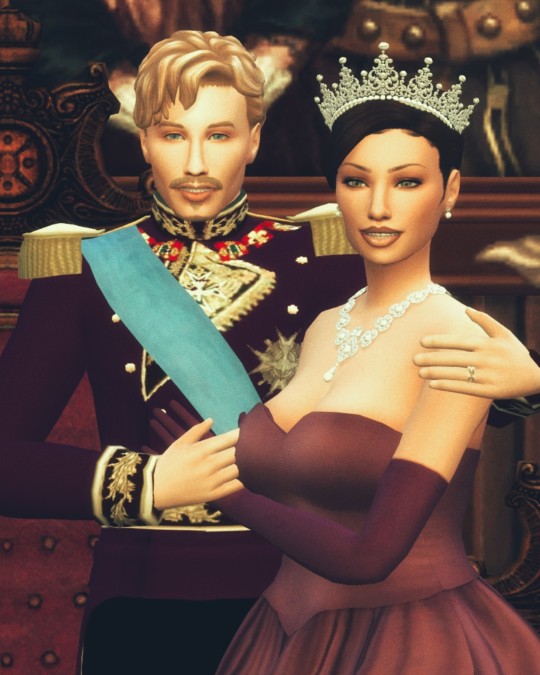
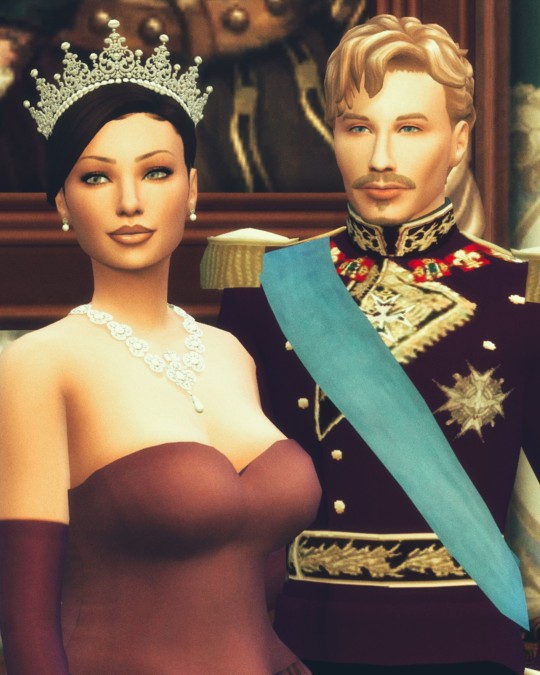

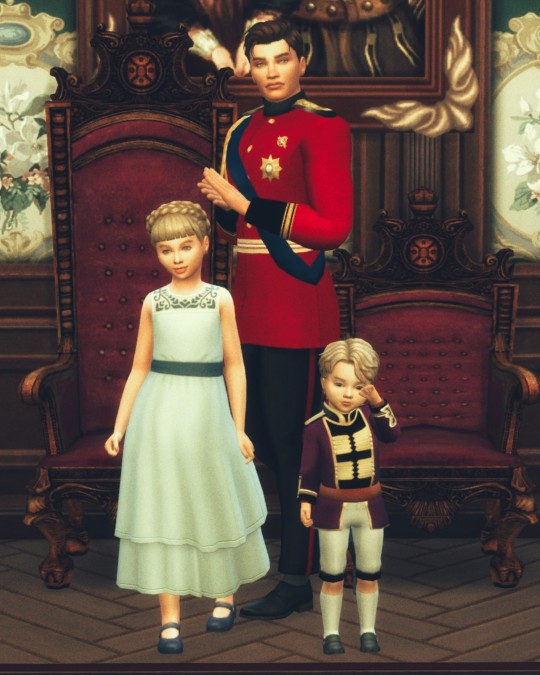
[ROYAL SERIES] - Germany's Royal Family
King Felix and Queen Sophia Schmidt of Germany. They have three children; Prince Gustav, Princess Louisa and Prince Finn. Prince Gustav is the heir to the throne. Currently no official/formal alliances. However they get along with Italy 🇮🇹 and starting to become close with Tonga 🇹🇴. King Felix plans to host a small event inviting:
King Johnathan and Queen Bambee of France
King Akamu and Queen Kalea of Tonga
And Italian royals (I have to make that family).
Follow my Royal RP/Storyline on Instagram: crown_queen_bambee
#personal#in character#bambee and johnathan#king felix#queen sophia#prince gustav#princess louisa#prince finn#simsroyalty#sims royalty#sims 4 royalty#sims 4 royals#ts4 royalty#sims 4 rp#ts4 rp#sims 4 royal simblr#sims 4 storytelling#ts4 storytelling#royal simblr#simblr
8 notes
·
View notes
Text
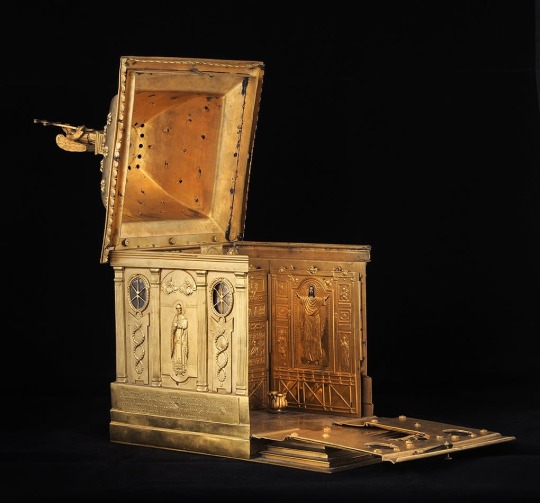
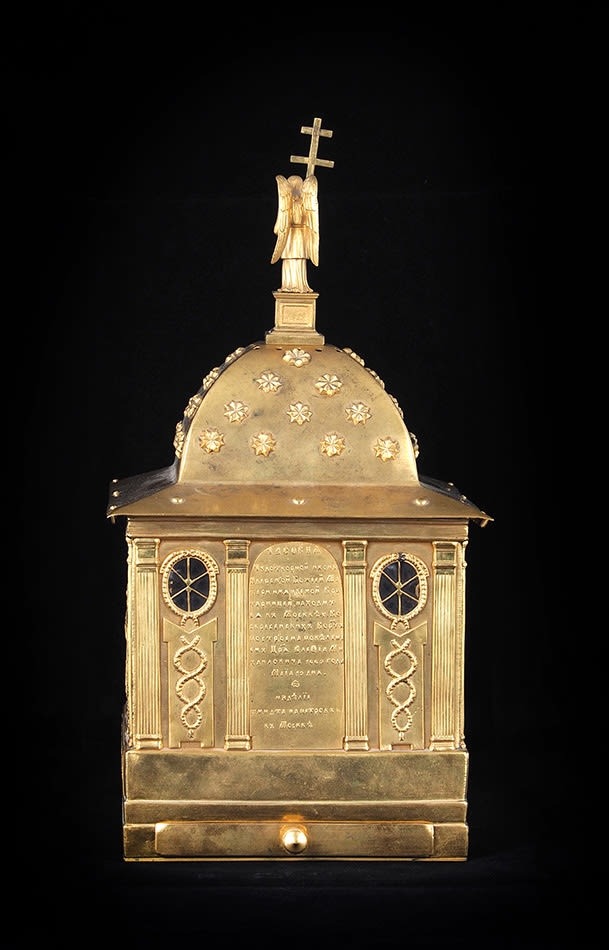


Model of the chapel of Our Lady. Russia, Gustav Schmidt's Bronze Mill. 1850s - 1860s.
Bronze, brass, mica, rhinestones in castes; casting, embossing, gilding, hammering.
On the stairs there is an inscription in bronze: "G. SHMIDT."
Similar models of the chapel are stored in the collections of the State Hermitage Museum and the State Historical Museum.
"This is a model of the Ivera Chapel near the Kremlin Wall. You can put a candle in it, close the doors, and the light will break through the mica window... We have two such chapels, and both of them are a terrible rarity..." (Head of the Metal Department of GIM L. Dementieva about a similar model from the GIM collection).
A née German, Gustav Schmidt, from the 50s until the end of the 80s of the XIX century, owned a bronze foundry factory located in Moscow on Pyatnitskaya Street. The factory's products were sold in Schmidt's own store on Petrovka. The assortment of the factory included miniature models of famous historical monuments, among them - Tsar-Bulokol and Tsar Cannon, a monument to Peter I and many other models of well-known and recognized monuments. As stated in the advertisement of the factory G. Schmidt, the products were able to satisfy the most "pretentious taste and requirements of real fashion." The works of the factory made of gilded and patinated bronze, characterized by high craftsmanship and quality, were souvenir, gift in nature and were very popular among buyers.
Some items were made to order. For example, in the 1850s, the owner of the Arkhangelskoye estate Nikolai Borisovich Yusupov Jr. (1828-1891) ordered Gustav Schmidt a model of the monument to Minin and Pozharsky, which is still a decoration of the estate collection.
Litfund
13 notes
·
View notes
Text
Cincinnati Bootblacks Organized To Fight Free Shine Services By Local Merchants
The opening of a new shoe store in 1895 caught the attention of Cincinnati’s bootblacks, and they weren’t happy at all.
The Smith, Kasson & Co. store on the north side of Fifth Street, just east of Race, promised high quality footwear at prices affordable to the masses. George Smith, Henry Kasson and their partners indulged their customers with luxurious extras. An orchestra performed amid veritable gardens of potted plants. The décor was all of brass setting off maroon leather. An X-ray device assured a precise fit. The store offered, whether you were a customer or not, to shine your shoes for free. There was the rub.
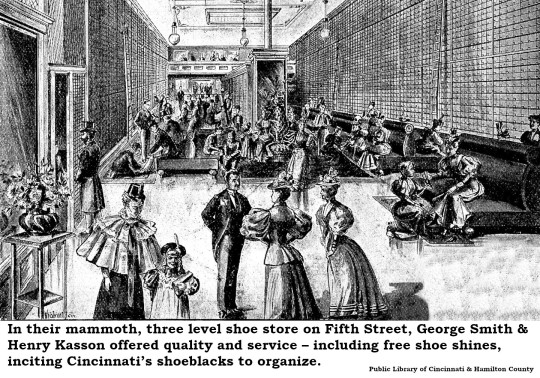
Outside on the streets, dozens of bootblacks braved the entire panoply of Cincinnati weather to shine shoes for a dime, rarely pulling in a dollar a day. Some of the city’s “shine artists” occupied a stand in a barber shop or shine salon, but they were few and charged more.
To aggravate the situation, companies that manufactured shoe polish didn’t distribute through general stores. Shoe polish was sold only at shoe stores, forcing bootblacks to buy their supplies from the very establishments taking away their livelihood by offering free shines.
Christmas season in 1897 found Cincinnati’s shoeshine “boys” (most were grown men) on starvation rations as more and more businesses – not only shoe stores, but department stores as well – offered free shines. By January 1898, the bootblacks reached the boiling point. The raggle-taggle group announced a meeting and invited Mayor Gustav Tafel to attend. According to the Cincinnati Post, Mayor Tafel was sympathetic to the cause:
“The mayor has not patronized stores at which free shines were given, and either does the work himself or pays for having his boots polished. He favors the antifree-shine movement on behalf of the bootblacks.”
The Post, sensing an issue on which to build its reputation as the city’s progressive newspaper, provided extensive coverage of the dispute. In an editorial [1 February 1898] the newspaper announced its support:
“Everybody is talking about the bootblacks! Manly determination is always admirable. The assertion of the bootblacks that “Free shines is got to go!” carries with it the assumption of good argument. Give the bootblacks a fair hearing.”
Post reporters gathered quotes of support from prominent men, such as city councilman John Wahburn:
“A man does not expect free shoes. Why should he expect free shines? Let us all pay for both.”
The Post also collected endorsements from some of the city’s less-respectable celebrities, including Dan Bauer, who owned the notorious Majestic Concert Hall that the Post would rail against a few years later:
“Give the bootblacks what is due them. They are entitled to the business.”
The Post also collected letters from bootblacks outlining their grievances. Some were printed with grammatical and spelling mistakes patronizingly preserved. One correspondent, William H. Schmidt, stated the case eloquently:
“Some people are inclined to think the bootblacks are a band of mongrels, uneducated and indifferent to circumstances. I want to say to these people that there are scores of us who are really worthy of better employment. We can’t get it, and accordingly make the best of our lot.”
On Tuesday morning, the first of February, the city’s bootblacks gathered at the College Hall on Walnut Street to discuss strategy. Temporary chair of the meeting was Harry Lemmon, who was not a bootblack at all, but an inspector at the Customs House. Lemmon introduced a motion to select a permanent chair when a disturbance halted the proceedings. According to the Post [1 February 1898]:
“There was some commotion in the hall. The doors burst open and in came 50 more bootblacks. One was playing a harp and others were cheering. It was five minutes before the election was resumed.”

The newcomers were a delegation of shoe-shiners who had rallied around their own celebrity, featherweight boxer Albert “Kid Ashe” Laurey. The Kid was no bootblack, but he was a popular athlete and was soon elected president of the meeting. Laurey, an African American, underlined the multiracial make-up of the bootblack constituency. Though the papers didn’t make much of the inclusive nature of the movement, it was probably the only integrated union in Cincinnati at the time, the other trades maintaining strictly segregated locals.
The lively group soon organized as the Cincinnati Bootblacks Protective Association, and drafted a petition demanding that Cincinnati merchants cease offering free shoeshines by the end of the week. In the back of the room, a man rose and announced that his employer, Mabley & Carew, would stop the practice immediately. Representatives of Rollman & Sons, Potter Shoes, the Foreman Shoe Company and Smith, Kasson & Co. were also present and agreed to end the service as well. In short order, the rest of the city’s merchants fell in line.
The association agreed to charge 10 cents for a shine and to levy dues of 10 cents a week to build up a fund for homeless and hospitalized members. The Cincinnati Post had one of the staff artists design an insignia for the group.
Although victorious in their initial battle, the war went on for years. By Thanksgiving, a few stores again began shining shoes as a complementary service. The Cincinnati Bootblacks Protective Association had gone largely inactive and had to be revived to counter this new threat. The association was revived again in 1901 after a couple years of inactivity, and yet again in 1905.
More disconcerting was a threat from within the bootblack community. A “trust” organized by unaffiliated bootblacks opened a shine parlor and only charged a nickel. The association sent a persuasive delegation to convince them that going out of business was a healthy decision.
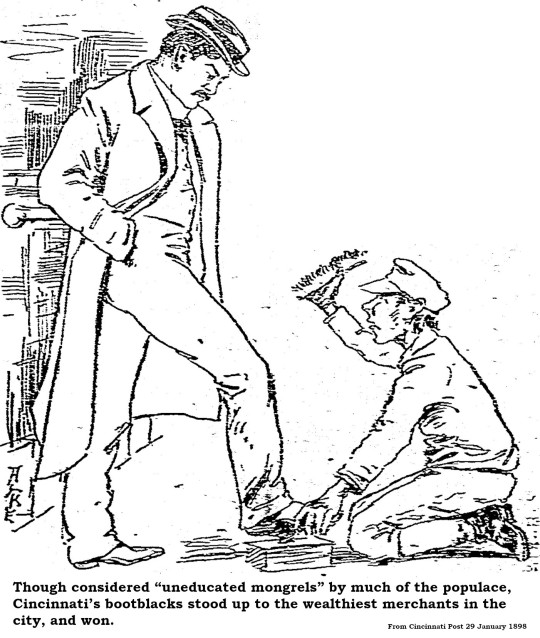
#cincinnati bootblack protective association#cincinnati bootblacks#smith kasson comapny#cincinnati labor
4 notes
·
View notes
Photo

Marie Gutheil-Schoder (16 February 1874 – 4 October 1935) was an important German soprano.
Born Marie Schoder in Weimar, she married Gustav Gutheil in 1899, with whom she lived until his death in 1914. In 1920, she married the photographer Franz Xaver Setzer.
She debuted in the secondary role of the First Lady at the Weimar Court Opera in The Magic Flute in her native city of Weimar in 1891. Gustav Mahler engaged her for the Vienna State Opera in 1900, where she remained until 1926. She appeared at the Royal Opera House as Octavian in Der Rosenkavalier in 1913. One of her famous roles was her portrayal of a "strange, Nietzschean" Carmen. She was seen in the 1914 Vienna premiere of Richard Strauss's ballet, Josephslegende as Potiphar's Wife. She created Esmeralda in the world premiere of Franz Schmidt's opera Notre Dame in the same year.
Gutheil-Schoder created the fiercely difficult single role of Arnold Schoenberg's monodrama Erwartung in 1924 in Prague; earlier that year, she performed his Pierrot lunaire. Mahler termed her "a musical genius," and she was highly regarded as a musician and singing-actress, although she seemed to be, as one Viennese critic wrote, "the singer without a voice." In her later career, she became a stage director of opera.
She was a well-known pedagogue as well, one of her students being the mezzo-soprano Risë Stevens. She died at the age of 61, in Ilmenau, Germany.
#Marie Gutheil-Schoder#women in art#women in music#XIX century#XX century#people#photo#photography#Black and White
4 notes
·
View notes
Text

Abenddämmerung (Evening Twilight) by Carl Gustav Carus, €280,000 (£239,315) at Schmidt.
The work depicts a scene from Johann Wolfgang Goethe’s drama Faust. Faust and his assistant Wagner stand on a hill, looking down on a town in the last light of day.
0 notes
Text

Karl Korn: Beiträge in der MEDAMANA 1980-1996
Quelle: https://www.aulemettmanner.de/pdf/Medamana%20Inh.%20Verz%201954%20-%202020.pdf
Andreas Korn: Mein Vater Karl Paul Korn - Heimatforscher in Mettmann
Für die Medamana - Heimatblatt der Vereinigung "Aule Mettmanner" hat mein Vater und leidenschaftlicher Heimatforscher eine große Anzahl an Beiträgen verfasst. Freundlicherweise hat die Redaktion der Medamana die Inhaltsverzeichnisse 1954-2020 online gestellt.
Daraus konnte ich die Essays meines Vaters identifizieren und hier zusammentragen. In dem Autorenverzeichnis sind mir auch einige Personen aufgefallen, mit denen mein Vater in Verbindung gestanden hat.
Dies sind beispielsweise diese Persönlichkeiten, an die ich hier gerne erinnere: Dr. Karl Klockenhoff, Prof. Georg Kuhlmey, P. Winkels, Kanonikus Dr. Kessel, Gertrud Middell, Horst-G. Hütten, Bürgerm. W. Voß, Bernd Gansauer, Gustav Voß, Fritz Löckenhoff, Paul Kriegel, Michael Schaffers, Helmut Kreil u.a.
Zugleich ist anzumerken, dass Karl Korn mit einigen persönlichen Forschungsschwerpunkten (wie St. Lambertus, Chronik der Familie Korn, St. Caecila Hubbelrath) zum Teil umfangreiche Abschrift- und Manuskriptsammlungen in kleinen eingebundenen Editionen zusammengetragen hat. Meine Bibliografie gibt hier Interessierten Auskunft.
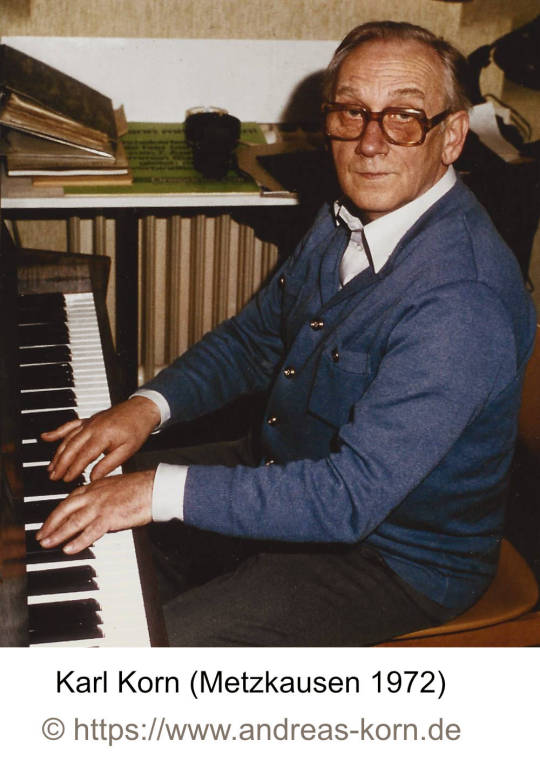
(Foto beim Klavierspiel auf einem Klavier aus Emmerich von Tetsch & May, dem Geburtsort seiner Frau Klara Korn, geb. Schmidt)
Aufstellung der Beiträge von Karl Korn in der Mettmanner MEDAMANA
Medamana Nr. 3 27. Jahrgang Oktober 1980
Karl Korn: Ruhrgebietsbesatzung in Mettmann, S. 74
Karl Korn: Besetzung der Bürgermeisterei Hubbelrath, S. 82
Medamana Nr. 4 27. Jahrgang Dezember 1980
Karl Korn: "Em Hassel wued en Kerk jebout", S. 98
Karl Korn: Winter am Eidamhauser Berg, S. 110
Medamana Nr. 4 28. Jahrgang Dezember 1981
Karl Korn: Aus der Schulchronik der Schule Obschwarzbach, S. 74
Medamana Nr. 1 29. Jahrgang April 1982
Karl Korn: 75 Jahre Max Hoffstaedter, S. 6
Karl Korn: Aus der Chronik der kath. Schule Obschwarzbach (Teil 2), S. 15
Medamana Nr. 3 29. Jahrgang Oktober 1982
Karl Korn: 75 Jahre Weltspiegel Kino, S. 8
Medamana Nr. 1 30. Jahrgang April 1983
Karl Korn: Vor 100 Jahren Neubau der Lambertus Kirche, S. 2
Medamana Nr. 3 36. Jahrgang September 1989
Karl Korn: Mettmann im Kriege 1939-1940, S. 45
Medamana Nr. 4 36. Jahrgang Dezember 1989
Karl Korn: Mettmanner im Krieg 1939-1941 (Teil 2) , S. 67
Medamana Nr. 1 38. Jahrgang April 1991
Karl Korn: Sedan-Feier vor 120 Jahren , S. 16
Medamana Nr. 4 38. Jahrgang Dezember 1991
Karl Korn: Kreuzkasel aus der Pfarrkirche Mettmann, S. 83
Medamana Nr. 4 39. Jahrgang Dezember 1992
Karl Korn: Pfarrer Edmund Nießen gestorben, S. 74
Medamana Nr. 4 40. Jahrgang Dezember 1993
Karl Korn: Die Glocken von St. Lambertus , S. 63
Medamana Nr. 4 41. Jahrgang Dezember 1994
Karl Korn: Die Meßdiener von St. Lambertus, S. 79
Medamana Nr. 2 42. Jahrgang Juni 1995
Karl Korn: Aus der Geschichte der Evangelischen Schulen 1630-1939, S. 36
Medamana Nr. 4 43. Jahrgang Dezember 1996
Karl Korn: SPARTAKUS-Aufstand in Mettmann und Hubbelrath, S. 77
+ + +
Dr. Andreas Korn, 10.10.2023
Foto aus dem Familienarchiv: Karl Korn beim Klavierspiel in Metzkausen in der Hasselerstraße 53 um 1972.
+ + +
0 notes